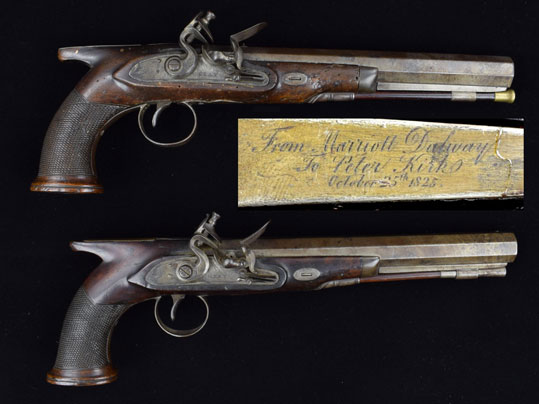DALWAY/CHICHESTER DUELLING PISTOLS
Published in Artefacts, Issue 1 (January/February 2023), Volume 31By Hugh Stephenson
‘Did he blaze?’ The question, reported by Jonah Barrington to establish the character of a young man, reflected the rage for duelling in Ireland in the late eighteenth and early nineteenth centuries. Dueling has a long history in Ireland and originated in judicial trials by combat. The practice of dueling was effectively democratized between 1780 and 1820 when the use of pistols leveled the competition. Swords, having been typical prior to 1780, gave considerable advantage to those with training, military types and taller men. Pistols significantly equalized the odds for anyone who felt their honour slighted. While duels were frequent, surviving duelling pistols are scarce, and rarely can guns used in a specific duel be identified. This, however, is the case with this pair of Irish duelling pistols, thanks to the commemorative plaques attached and the increasing digitisation and accessibility of early records.
The locks are marked ‘Gray’ for John Gray, who came to Dublin from Edinburgh in the 1770s. He initially worked for Lewis Alley, who trained in Scotland. Gray was listed in Dublin at 21 Blind Quay in 1782 and in other locations, ending at 46 Moore Street from 1814 to 1830. Interestingly, the barrels are marked ‘John Richards’ (London, 1760–1821), and it is likely that these pistols were rebuilt by Gray c. 1815 using barrels from older family guns, a not-uncommon practice. The iron-mounted pistols have saw-handled grips, which became fashionable around 1810. The raked style provided a longer sight plane. They are heavier than earlier guns, steadying the hand of the novice shot. The barrels are 9.5 inches long and .58 calibre, with hooked breeches, platinum-lined touch-holes and simple notch-and-blade sights. The spur of each gun bears a silver plate inscribed ‘From Marriott Dalway to Peter Kirk, October 25th 1825’.
Marriott Dalway (1798–1869) of Bella Hill, Co. Antrim, descended from a Carrickfergus planter line. His father, Noah Dalway (born Noah Webb), was a naval captain and MP for Carrickfergus. He took the name Dalway from his wife’s maternal uncle in 1795 when he inherited Bella Hill. Marriott himself graduated from Trinity College in 1823 and was both high sheriff and mayor of Carrickfergus. Peter Kirk, to whom the pistols were presented, was married to Ellen Dalway, Marriott’s sister. Kirk was MP for Carrickfergus from 1835 to 1847. A notice from the London Morning Post of 31 October 1825, copied from the Dublin Morning Post, reads:
‘Duel.—A meeting took place near Carrickfergus, on Tuesday morning, at ten o’clock, between Sir A Chichester Bart. the present representative for Carrickfergus and Marriott Dalway Esq. a candidate for the representation of the borough. The former was attended by Sir Stephen May and the latter by Mr. Burleigh of Burleigh hill. The parties exchanged two shots without effect. The quarrel, we understand, originated in electioneering politics.’
Sir Arthur Chichester of Greencastle (1769–1847) was the MP for Carrickfergus and was captain of the Moville Infantry in 1815. One of his ancestors, also Arthur Chichester, was lord deputy of Ireland from 1604 to 1614.
The Tuesday mentioned in the Post was 25 October. The shots exchanged did not cause injury, possibly intentionally—a common way to satisfy honour. Dalway and Chichester would have interacted closely in their subsequent civic roles. Dalway presented the pistols to Kirk afterwards.
The pistols are an unusually specific reminder of the trajectory of Irish politics and culture in the late eighteenth and early nineteenth centuries. As in other countries, men—especially those who were born into wealth, power and privilege—were willing to risk death rather than have their character slighted. The apparently low value placed on their own lives relative to their reputations is an important factor in understanding life and culture in this period.
Hugh Stephenson is a clinical psychologist and associate professor at Ithaca College, NY.

















